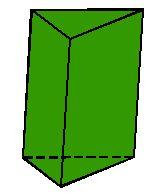Right prism
The base of the right prism is a right triangle with leg a = 5 cm and a hypotenuse c = 13 cm. The height of the prism is equal to the circumference of the base. Calculate the surface area and volume of the prism.
Final Answer:

Tips for related online calculators
See also our right triangle calculator.
Tip: Our volume units converter will help you convert volume units.
See also our trigonometric triangle calculator.
Tip: Our volume units converter will help you convert volume units.
See also our trigonometric triangle calculator.
You need to know the following knowledge to solve this word math problem:
arithmeticsolid geometryplanimetricsUnits of physical quantitiesGrade of the word problem
Related math problems and questions:
- Prism
 A right-angled prism, whose base is a right triangle with leg a = 3 cm and hypotenuse c = 6 cm, has the same volume as a cube with an edge length of 1 dm. a) Find the height of the prism b) Calculate the surface of the prism c) What percentage of the cube
A right-angled prism, whose base is a right triangle with leg a = 3 cm and hypotenuse c = 6 cm, has the same volume as a cube with an edge length of 1 dm. a) Find the height of the prism b) Calculate the surface of the prism c) What percentage of the cube - Calculate a prism
 Calculate the volume and surface area of a prism whose height is 16cm and whose base is a right triangle with sides of 5cm and 12cm and a hypotenuse of 13cm.
Calculate the volume and surface area of a prism whose height is 16cm and whose base is a right triangle with sides of 5cm and 12cm and a hypotenuse of 13cm. - Triangular prism
 The base of the perpendicular triangular prism is a rectangular triangle with a hypotenuse of 10 cm and one leg of 8 cm. The prism height is 75% of the perimeter of the base. Calculate the volume and surface of the prism.
The base of the perpendicular triangular prism is a rectangular triangle with a hypotenuse of 10 cm and one leg of 8 cm. The prism height is 75% of the perimeter of the base. Calculate the volume and surface of the prism. - Triangular prism
 Calculate the volume and surface of the triangular prism ABCDEF with the base of an isosceles triangle. Base's height is 16 cm, leg 10 cm, base height vc = 6 cm. The prism height is 9 cm.
Calculate the volume and surface of the triangular prism ABCDEF with the base of an isosceles triangle. Base's height is 16 cm, leg 10 cm, base height vc = 6 cm. The prism height is 9 cm. - Triangular prism
 Calculate a triangular prism if it has a rectangular triangle base with a = 4cm and hypotenuse c = 50mm, and the height of the prism is 0.12 dm.
Calculate a triangular prism if it has a rectangular triangle base with a = 4cm and hypotenuse c = 50mm, and the height of the prism is 0.12 dm. - Triangular prism
 The base of the perpendicular triangular prism is a right triangle with a leg length of 5 cm. The area of the largest sidewall of its surface is 130 cm², and the body's height is 10 cm. Calculate its volume.
The base of the perpendicular triangular prism is a right triangle with a leg length of 5 cm. The area of the largest sidewall of its surface is 130 cm², and the body's height is 10 cm. Calculate its volume. - Prism height
 What is the height of a prism with a right triangle base and sides of 6 cm and 9 cm? The hypotenuse is 10.8 cm long. The volume of the prism is 58 cm³. Calculate its surface area.
What is the height of a prism with a right triangle base and sides of 6 cm and 9 cm? The hypotenuse is 10.8 cm long. The volume of the prism is 58 cm³. Calculate its surface area.
